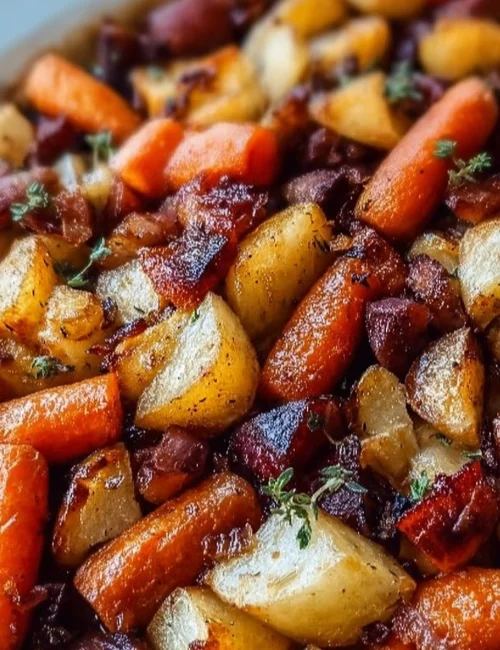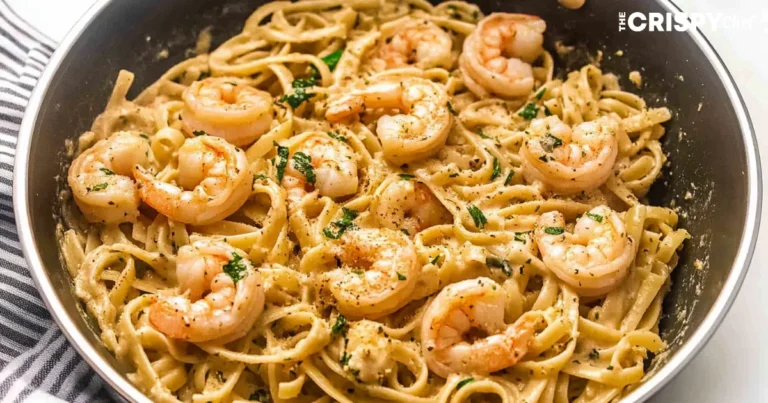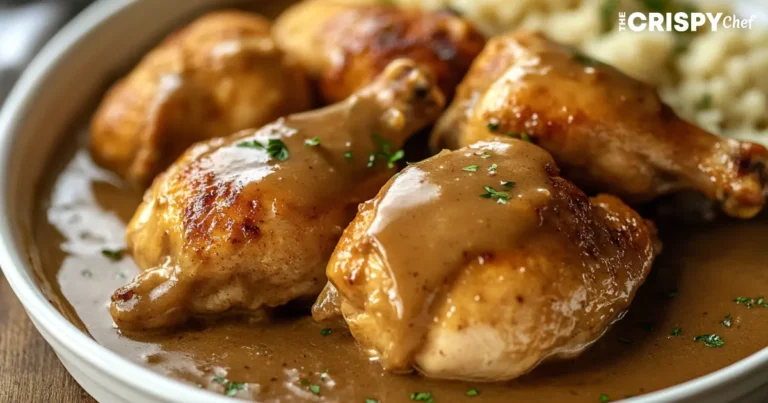Making your own walnut pesto recipe is easy and fun. It’s a tasty twist on the classic basil pesto, using walnuts instead of pine nuts. This sauce is bright and flavorful, great for pasta, sandwiches, dips, or toppings.
With just a few fresh ingredients and a food processor, you can make a batch quickly.
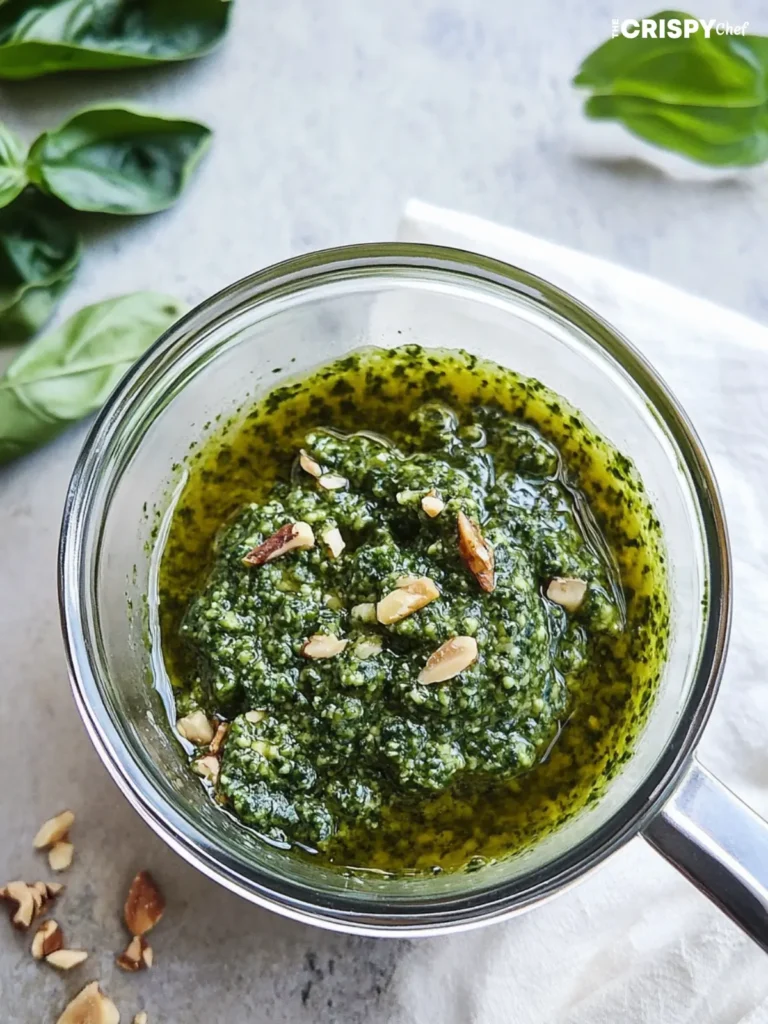
Key Takeaways
- Homemade walnut pesto is a flavorful and cost-effective alternative to traditional pine nut pesto
- Walnuts are more affordable than pine nuts, making this recipe budget-friendly
- The pesto can be easily customized to your taste preferences and dietary needs
- This recipe yields a large batch that can be frozen for long-term storage
- Walnut pesto is versatile and can be used in a variety of dishes beyond just pasta
The Perfect Alternative to Traditional Pine Nut Pesto
If you love pesto but pine nuts are too pricey, walnuts are a great choice. They’re cheaper and add a rich, earthy taste. Plus, they make pesto creamy and smooth.
Why Choose Walnuts Over Pine Nuts
Walnuts are a smart pick for pesto because they’re affordable. A big bag of walnuts costs about $20 on Amazon. Pine nuts, on the other hand, can cost over $26 for a smaller bag.
Cost Comparison and Benefits
Walnuts are not just cheap; they’re also packed with nutrients. They have omega-3s, antioxidants, and important vitamins and minerals. Adding walnuts to pesto makes it healthier and more nutritious.
Nutritional Advantages of Walnuts
Walnuts are full of good fats, protein, and fiber. They also have plant compounds like polyphenols and ellagic acid. These can help your health. Using walnuts in pesto makes it tasty and good for you.
Choosing between pine nuts and walnuts for pesto depends on what you like and your budget. But walnuts are a tasty, healthy, and cheaper option. They’re a great choice for anyone looking for a different pesto.
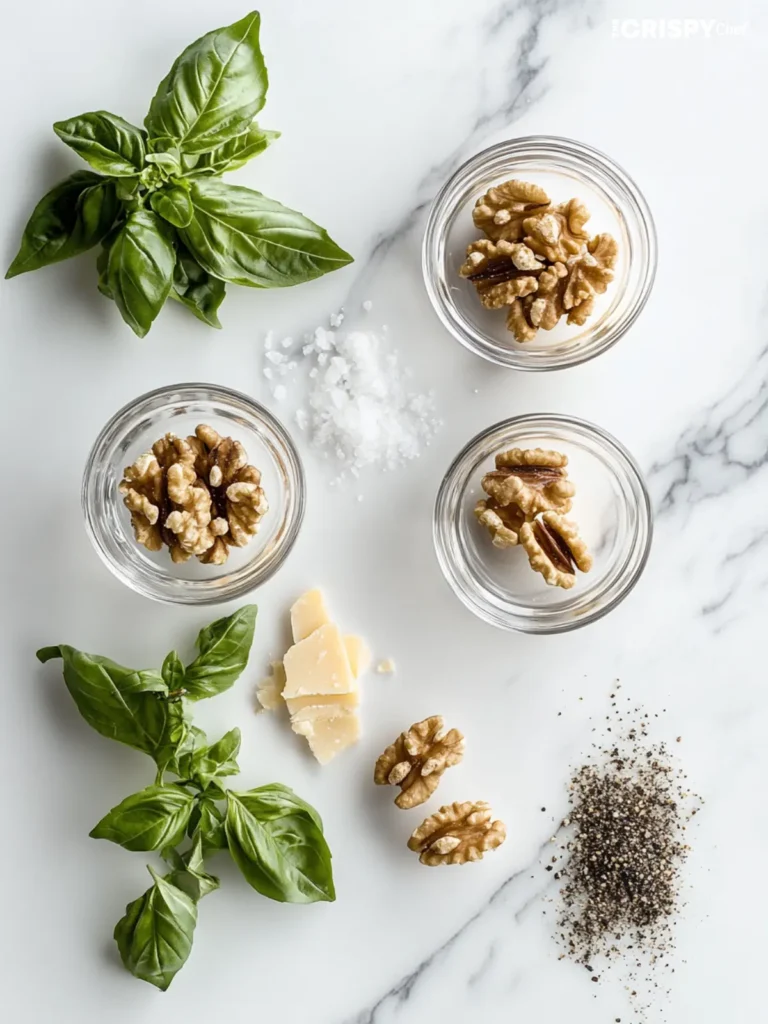
Essential Ingredients for Your Walnut Pesto Recipe
Making walnut pesto at home is simpler than you think. You’ll need fresh basil leaves, raw walnuts, garlic, salt, Parmigiano-Reggiano cheese, and extra virgin olive oil. Using top-quality ingredients ensures your pesto tastes amazing.
Begin with 2 cups of fresh basil leaves. They should be bright green and smell great. Then, add ¼ cup of raw walnuts. Lightly toasting them can make their flavor even better.
For the cheese, choose Parmigiano-Reggiano from Italy. It has a richer taste than domestic Parmesan. You’ll also need ½ teaspoon of garlic paste or 1 large clove, ½ teaspoon of salt, and ⅛ teaspoon of black pepper. Lastly, use ⅓ to ½ cup of extra virgin olive oil to mix everything together.
With these ingredients, you can make pesto with walnuts at home. Enjoy the fresh, vibrant flavors of this versatile sauce.
| Ingredient | Quantity |
|---|---|
| Fresh Basil Leaves | 2 cups, firmly packed |
| Raw Walnuts | ¼ cup |
| Parmigiano-Reggiano Cheese | ¼ cup, grated |
| Garlic | ½ teaspoon paste or 1 large clove |
| Salt | ½ teaspoon |
| Black Pepper (optional) | ⅛ teaspoon |
| Olive Oil or Extra Virgin Olive Oil | ⅓ to ½ cup |
Kitchen Tools and Equipment Needed
To make your own walnut pesto sauce, you’ll need some basic kitchen tools. You’ll need a food processor or a blender. A food processor is better for pesto because it gives a chunkier texture.
You’ll also need a sharp knife, a strong cutting board, and measuring cups and spoons for the right amounts. A flat spatula is useful for getting all the ingredients mixed well.
Food Processor vs. Blender Options
Both food processors and blenders can make basil pesto sauce. But, they work differently. Food processors make a chunkier pesto because of their wide bowl. Blenders make a smoother pesto because of their tall, narrow shape.
Additional Helpful Tools
Toasting walnuts in a frying pan before making pesto adds flavor. It makes the pesto taste nuttier. Also, using a cheese grater for Parmesan cheese makes the pesto creamier and tastier.
Remember to stop and scrape down the sides of your food processor or blender. This makes sure everything gets mixed well.
Step-by-Step Preparation Guide
Making a tasty recipe for basil pesto with walnuts is easy. Just follow this simple guide to how to make walnut pesto at home. You’ll love the fresh, delicious taste.
- Begin by toasting the walnuts. Heat a dry skillet over medium-low heat and add the walnuts. Toast them for about 7 minutes, stirring occasionally, until fragrant and lightly browned. This step enhances the nutty flavor of the walnuts.
- While the walnuts are toasting, prepare the basil. Gently remove the leaves from the stems to measure out 2 packed cups of fresh basil.
- Peel and mince 1-2 garlic cloves, depending on your preference for garlic intensity.
- In a food processor, combine the toasted walnuts, basil, garlic, Parmesan cheese, and a pinch of salt. Process the ingredients until they form a smooth, uniform pesto.
- With the food processor running, slowly drizzle in the olive oil in a steady stream. Continue processing until the pesto reaches your desired consistency.
- Taste the pesto and adjust the seasoning as needed, adding more salt or a touch of lemon juice to balance the flavors.
Your homemade walnut pesto is now ready to enjoy! Use it as a versatile condiment, mix it with pasta, or spread it on toast for a delicious and nutritious meal.
“This walnut pesto is a game-changer! It’s so fresh, flavorful, and easy to make at home.”
Tips for Making the Perfect Walnut Pesto
Making a tasty walnut pesto needs a few key tips. First, toasting the walnuts brings out their oils and nutty smell. This makes the pesto taste better. Also, picking and handling fresh basil leaves is important. Blanch them in boiling water, then cool them in ice water to keep them green.
Toasting Walnuts for Enhanced Flavor
Toasting walnuts is a simple trick that boosts the flavor. Spread them on a baking sheet and bake at 350°F for 8-10 minutes. Stir them a few times until they smell good and are lightly browned. This step adds depth and richness to your walnut pesto.
Proper Basil Selection and Handling
Good basil leaves are key to a tasty pesto. Pick fresh, bright green basil without any wilt or color change. Rinse it well, then blanch in boiling water for 30 seconds. After that, cool it in ice water to keep its color bright.
Adjusting Consistency and Seasoning
The pesto’s thickness is up to you. Add olive oil slowly while blending for the right creaminess. For a thinner pesto, add more oil. For thicker, use less. Taste and adjust with salt, pepper, and lemon juice. Try different cheeses to find your favorite pesto mix.
By following these tips, you’ll make a delicious homemade walnut pesto. It’s great with pasta, on sandwiches, or as a dip.
Storage and Preservation Methods
Keeping your homemade walnut pesto fresh and flavorful is key. The right storage methods can help you enjoy it for weeks or months. Here’s how to keep your pesto at its best:
Refrigerator Storage
- Put pesto in an airtight container in the fridge for up to 1 week.
- Put a thin layer of olive oil on top to stop it from turning brown.
Freezing Pesto
Freezing is the best way to store pesto for longer. Here’s how to freeze your walnut pesto:
- Put the pesto in an airtight container or ice cube tray.
- Cover it with a thin layer of olive oil to keep it from changing color.
- Freeze it for up to 6 months.
- Once it’s frozen, move the pesto cubes to a sealable plastic bag for easy use.
Thaw frozen pesto cubes as needed for dishes like pasta, pizza, and sandwiches. By using these simple how to store pesto and freezing pesto tips, you can enjoy your homemade walnut pesto all year.
Creative Ways to Use Your Homemade Pesto
Discover the many uses of your homemade walnut pesto. It’s perfect for quick meals or special events. Its fresh, nutty taste can make any dish better.
Pasta and Pizza Applications
Try tossing walnut pesto with pasta for a tasty dinner. It coats the noodles beautifully, making the dish look and taste great. Use it as pizza base, then add your favorite toppings like veggies, tomatoes, and cheese.
Sandwich and Appetizer Ideas
Make your sandwiches better by adding walnut pesto. It’s great with turkey, avocado, or tomatoes. For a snack, serve the pesto with veggies, bread, or crackers. The options are endless with homemade walnut pesto recipes.
Be creative with your pesto uses. It’s great for pasta, sandwiches, and appetizers. Your homemade walnut pesto will be a kitchen favorite.
Recipe Variations and Substitutions
Homemade pesto is incredibly versatile. The classic walnut pesto is delicious, but you can try other nuts too. This makes it easy to find a pesto that you love.
Swap walnuts for almonds or pecans to mix things up. Marcona almonds add a creamy texture. Toasted pecans give a nutty flavor.
Don’t be afraid to change up the cheese too. Try pecorino romano or a mix of cheeses. A bit of crushed red pepper flakes adds spice. A squeeze of fresh lemon juice brightens the taste.
For a healthier option, add kale or other greens to your pesto. It’s packed with nutrients and tastes great. Just adjust the ingredients to your liking.
There are countless ways to make pesto. You can try different nuts and cheeses. Get creative and find the pesto that makes your taste buds dance.
Troubleshooting Common Pesto Problems
Homemade pesto is a culinary delight, but it comes with challenges. We’ve got you covered with our top tips for common issues like oxidation, browning, and texture problems.
Preventing Oxidation and Browning
Oxidation can turn your pesto brown and fade its color. Here are some simple steps to prevent it:
- Blanch your basil leaves briefly before using them in the pesto. This helps to “lock in” the color.
- Add a squeeze of fresh lemon juice to your pesto. The citric acid has natural antioxidant properties that can help preserve the color.
- Store your pesto with a thin layer of olive oil on top. This creates a protective barrier against air exposure.
Texture and Consistency Issues
If your pesto is too thick or too thin, there are easy fixes. For a thicker, creamier pesto, add a bit more olive oil. If it’s too thin, increase the cheese or nuts in the recipe.
Another tip is to process the ingredients in stages. Start by blending the basil, garlic, and nuts first. Then, slowly add the olive oil and cheese. This gives you more control over the final texture and consistency.
| Pesto Problem | Troubleshooting Tip |
|---|---|
| Oxidation and Browning | Blanch basil leaves before use Add lemon juice for antioxidant properties Store pesto with a layer of olive oil on top |
| Texture and Consistency | Adjust olive oil amount to achieve desired thickness Increase cheese or nuts for a thicker pesto Process ingredients in stages for better control |
By following these pesto troubleshooting tips, you can ensure your homemade pesto stays vibrant, flavorful, and the perfect consistency every time. Enjoy your fresh, prevent pesto browning pesto on everything from pasta to sandwiches and appetizers.
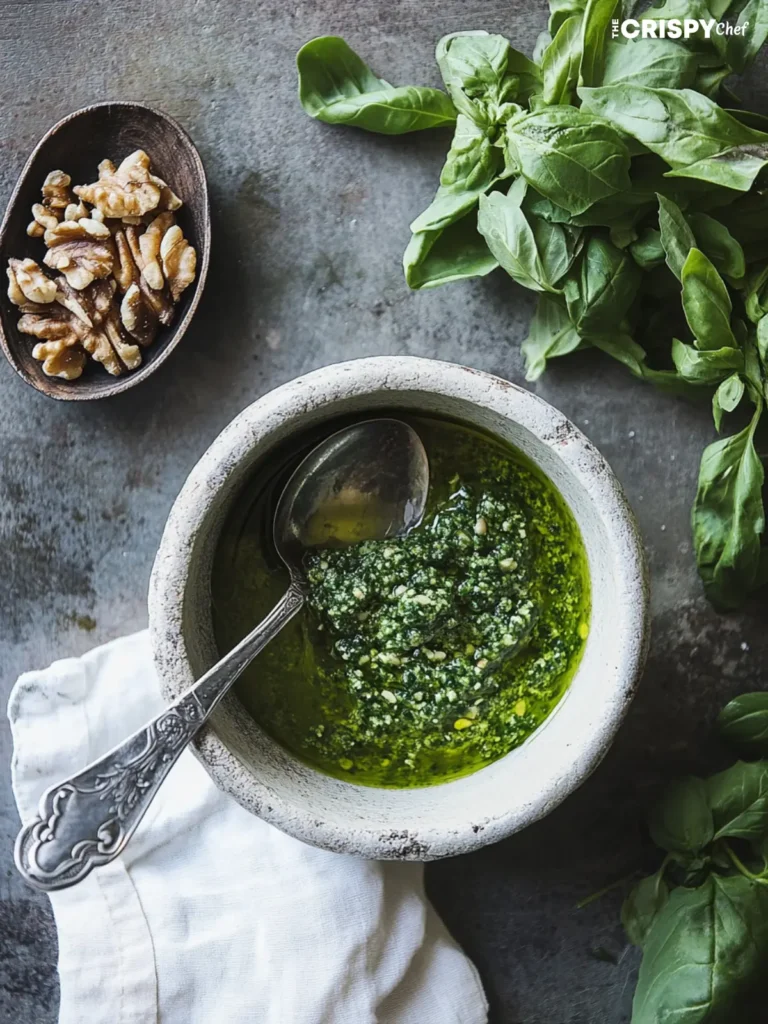
Conclusion
Homemade walnut pesto is a tasty, affordable, and easy alternative to pine nut pesto. This guide shows you how to make a fresh, delicious pesto at home. It’s perfect for any meal, big or small.
Walnuts in pesto offer many benefits, like being cheaper and healthier. Mixing walnuts with arugula and cheese gives a unique taste. It’s sure to wow your loved ones.
Feel free to try new things with your walnut pesto. Use it on pasta, sandwiches, or as a dip. Learning to make pesto opens up a world of flavors. It makes your meals special.
FAQ
What is the yield of this homemade walnut pesto recipe?
This recipe makes about 1.5 cups of pesto. You can double it for freezing.
Why are walnuts a more affordable alternative to pine nuts in pesto?
Walnuts are cheaper. A 40oz bag costs on Amazon. Pine nuts, a 16oz bag, are , making walnuts a quarter of the price.
What are the key ingredients for making walnut pesto?
You’ll need fresh basil, raw walnuts, garlic, salt, Parmigiano-Reggiano cheese, and extra virgin olive oil.
What tools are needed to make homemade walnut pesto?
You’ll need a food processor or blender, knife, cutting board, and measuring tools. A spatula is also helpful. A food processor is better for processing.
How do you toast the walnuts for the pesto?
Toast the walnuts in a dry skillet over medium-low heat for about 7 minutes. This enhances their flavor.
How should the basil leaves be prepared for the pesto?
Remove the basil leaves from the stalks and measure 2 packed cups. Blanch them briefly in boiling water. Then, plunge them into ice water to keep their color.
How should the pesto be stored for maximum freshness?
Store the pesto in an airtight container in the fridge for up to a week. Cover it with olive oil to prevent oxidation. For longer storage, freeze it in an airtight container or ice cube tray for up to 6 months.
What are some creative ways to use the homemade walnut pesto?
Use it on pasta, pizza, sandwiches, and as a dip. Mix it with sautéed summer vegetables and pasta. Spread it on flatbread pizza or use it in turkey sandwiches, on avocado toast, or in grilled cheese.
What are some variations or substitutions for the walnut pesto recipe?
Try substituting walnuts with almonds or pecans. Experiment with different cheeses like pecorino romano or a cheese blend. Add crushed red pepper flakes for spice or lemon juice for acidity. For a healthier option, try a kale pesto variation.
How can you prevent the pesto from browning?
To prevent browning, briefly blanch the basil leaves before use. Add lemon juice to the recipe for its antioxidant properties. Store the pesto with a thin layer of olive oil on top.
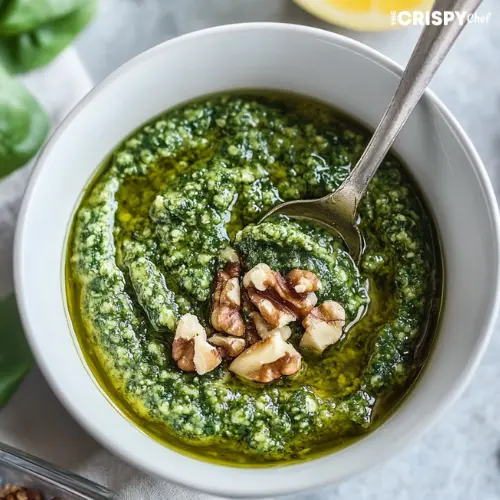
Homemade Walnut Pesto
Equipment
- Food processor or blender
- Measuring cups and spoons
- Sharp Knife
- Cutting board
- Flat spatula
- Skillet (for toasting walnuts)
Ingredients
- 2 cups fresh basil leaves firmly packed
- ¼ cup raw walnuts
- ¼ cup Parmigiano-Reggiano cheese grated
- ½ teaspoon garlic paste or 1 large clove minced
- ½ teaspoon salt
- ⅛ teaspoon black pepper optional
- ⅓ to ½ cup olive oil or extra virgin olive oil
Instructions
- Toast the walnuts in a dry skillet over medium-low heat for 7 minutes, stirring occasionally until fragrant and lightly browned. Set aside to cool.
- Prepare the basil by rinsing and measuring out 2 packed cups of leaves.
- Mince the garlic clove or use garlic paste.
- In a food processor, combine the toasted walnuts, basil, garlic, Parmesan cheese, and salt. Blend until smooth.
- While the food processor is running, slowly drizzle in olive oil until the desired consistency is achieved.
- Taste the pesto and adjust seasoning with additional salt or lemon juice, if desired.
- Store in an airtight container with a thin layer of olive oil on top to prevent browning.




